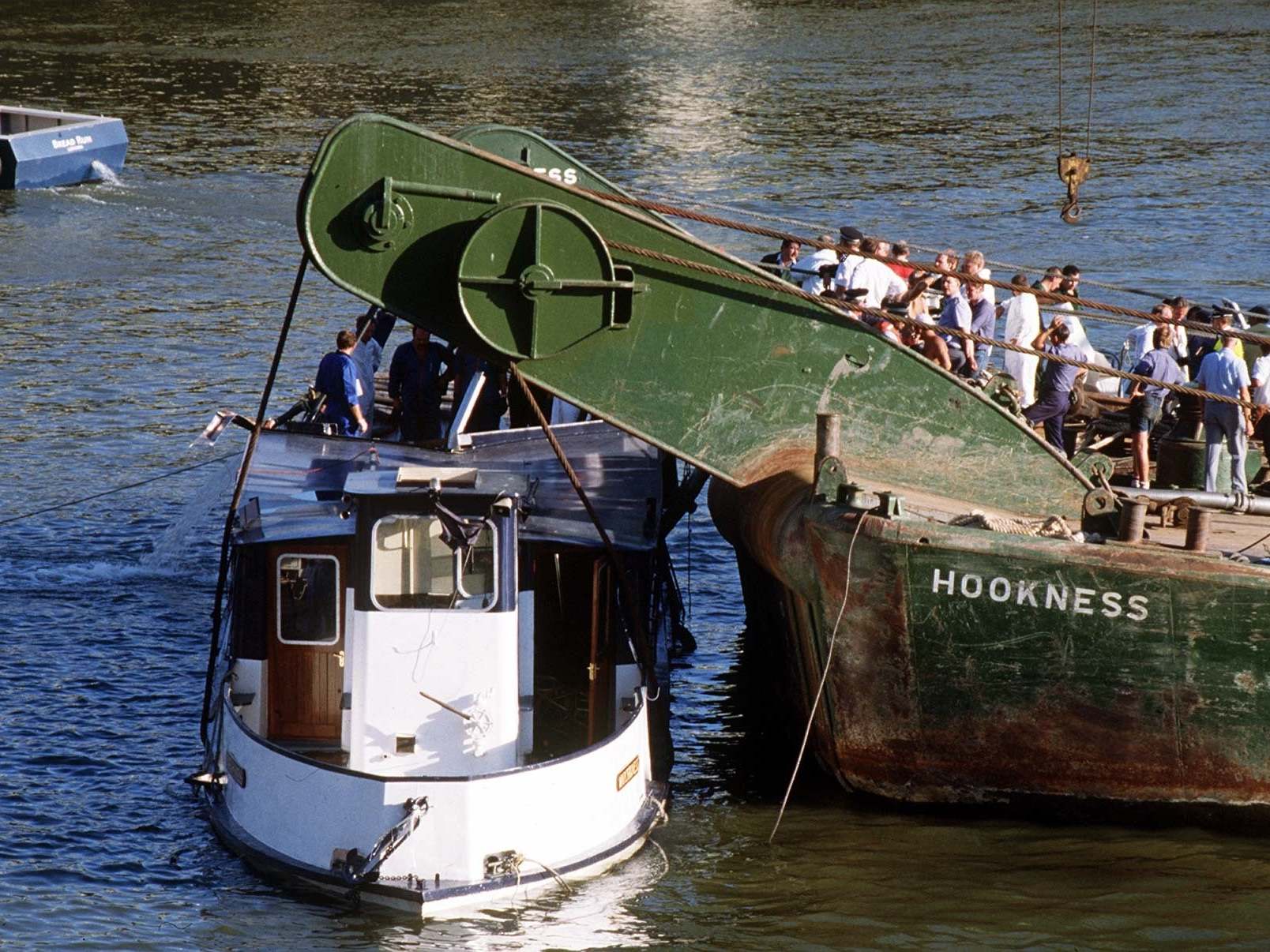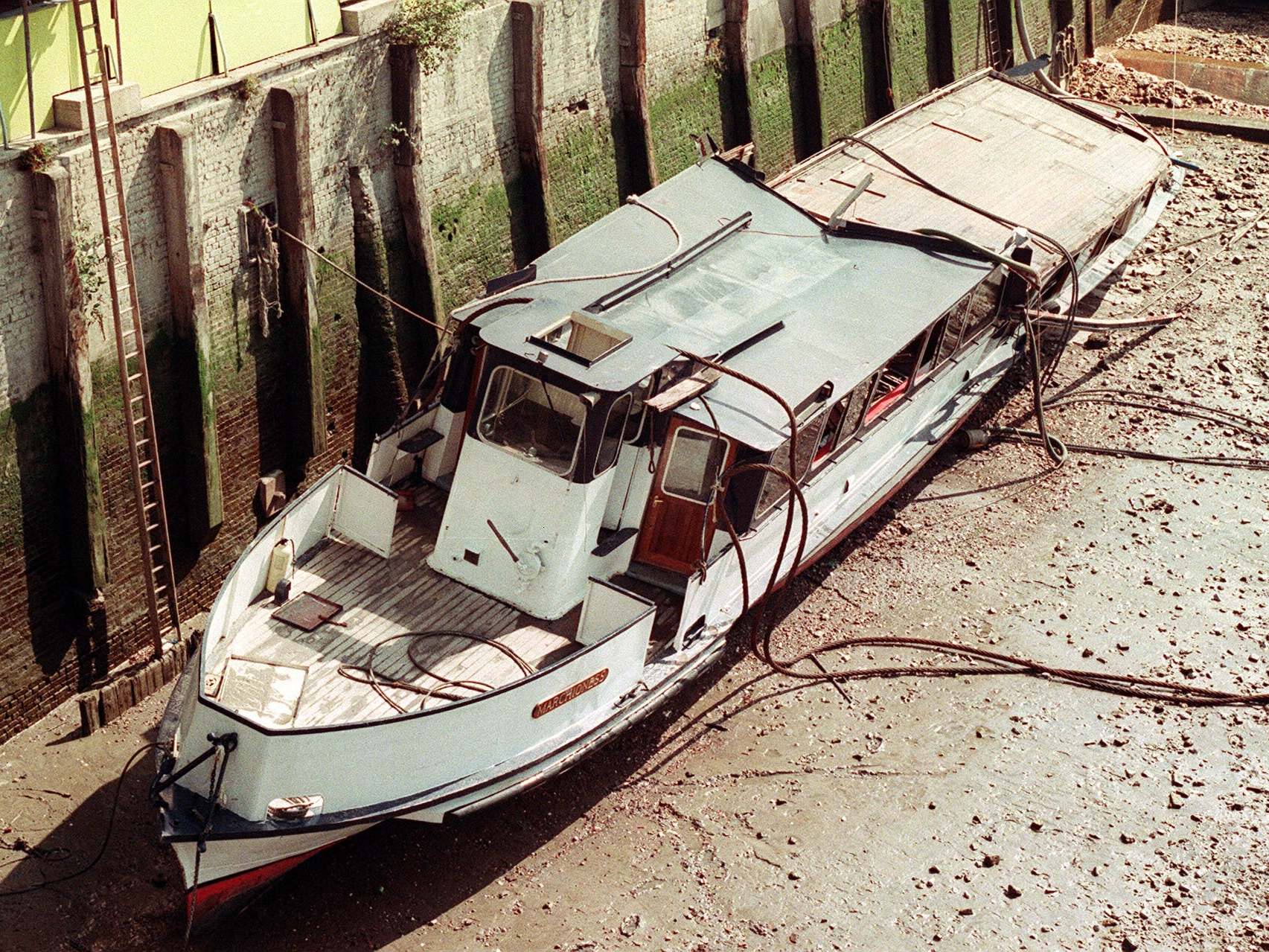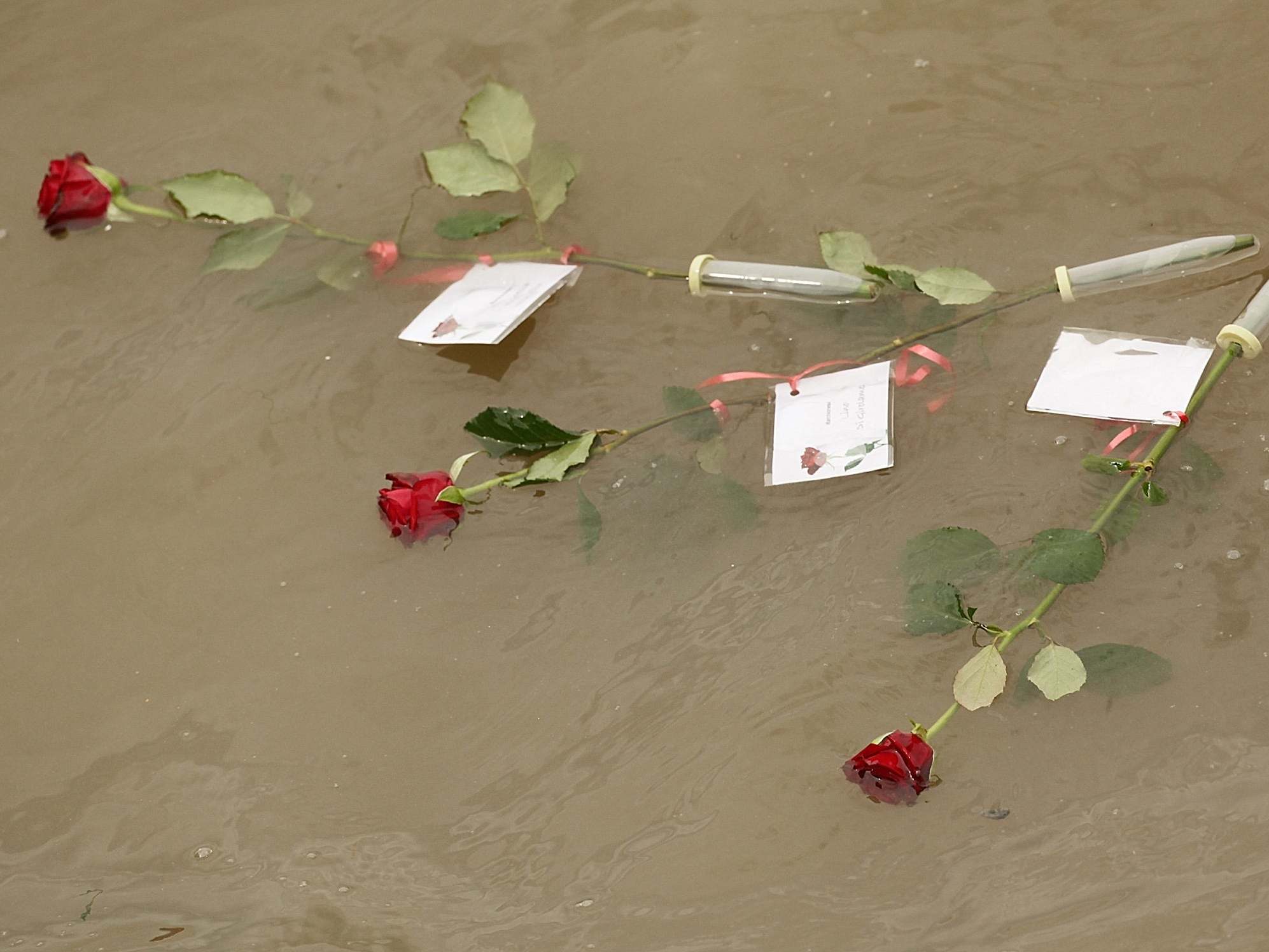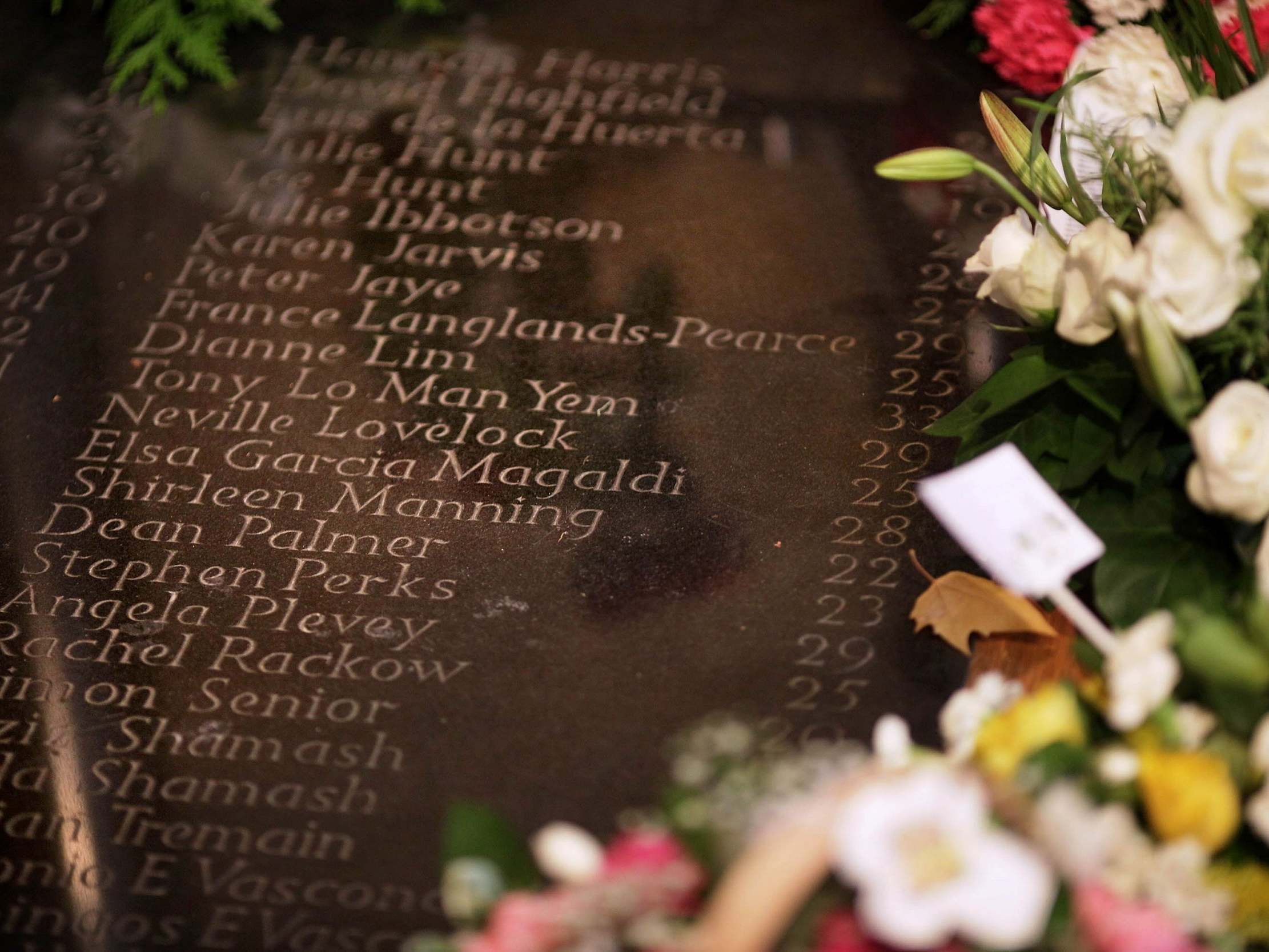Tragedy on the Thames: 30 years on, remembering the Marchioness disaster
On 20 August 1989, a packed pleasure boat was rammed and sunk by a dredger. For the survivors and grieving families of the 51 victims, the horror and injustice was only just beginning, writes Godfrey Holmes

And the dancing stopped. At precisely 1.46am on a clear, hot, still summer night, the dancing stopped. Thirty-one, at most 41, seconds later, very many revellers and their skipper were dead, drowned in the muddy, oily waters of London’s River Thames. Twenty-four celebrants of what was meant to be a very happy 26th birthday entombed, torpedoed, before they even had a slim – terrifyingly slim – chance of survival.
And shouldn’t it all have been different on such a romantic, moonlit voyage? Only a day earlier, and in good faith, Jon Phang had reserved the Marchioness for the birthday party for his friend, merchant banker Antonio de Vasconcellos. Portuguese in origin, both men had studied economics at Cambridge and remained the best of friends. The eight who knew Antonio best shared dinner in Jon’s flat before mid-evening on Saturday 19 August 1989. They would later be joined by 30 of Jon’s associates and colleagues for champagne and birthday cake. Then everyone, and quite a few more, would excitedly leave Soho for the Victoria Embankment, embarkation point for Tidal Cruises’ floating discos.
A few Marchioness merrymakers might have been “luckier” had they not thought too quickly to make a rational choice and trusted themselves to the treacherous currents swirling around and beneath the vessel that had been their aggressor, their undoing.

Yet six out of 10 people on board were miraculously rescued, no thanks to that same leviathan, the Bowbelle. Instead, it was crewman Andrew McGowan – later awarded a rare medal for courage – eight police officers and a number of passengers aboard another pleasure-boat, the passing Hurlingham, who responded quickest, pulling bedraggled and traumatised four-score young adults out of the dark depths competing for their lives.
The vessel these men and women were boarding, the Marchioness, had itself an illustrious past. As a steamship, she had been constructed by Salter Bros, of Oxford, in 1923, only eight years after its sister the Hurlingham. She was 85ft long, 14ft wide, 4ft draft, 33 tons in weight, with a permanent crew of two.
Open-decked, and with only an insubstantial awning, the Marchioness joined the Second World War effort as part of Thames Hospital Emergency Transport under its first captain, Joe Mears. It was even one of the little ships sent to evacuate shellshocked British troops from the beaches of Dunkirk at the end of May, 1940. Then came its diesel engines in the 1950s. Later, in 1979, Tidal Cruises, taking over from Thames Party Boats, modified the Marchioness superstructure to provide three decks accommodating over 120 people at a time, diners or passengers.
By way of contrast, aggressor Bowbelle – a concrete products’ dredger owned by East Coast Aggregates – was launched from Troon’s Ailsa Shipyard as recently as 1964: 262ft long, 45ft wide, tonnage 2,000, permanent crew of nine.
33 & 2,000
The tonnage of the Marchioness versus the Bowbelle, respectively
Whereas the Marchioness could progress niftily to and through the many arches of central London’s bridges, Bowbelle was provenly clumsy long before that fateful night in 1989. In July 1981, there was a collision between sister ship the Bowtrader and the passenger launch Pride of Greenwich. Then, only three months later, that same Bowtrader was involved in a collision with pleasure-boat the Hurlingham. Damningly, a terrible factoid for survivors of the Marchioness, the Bowbelle itself collided with Cannon Street railway bridge in May 1982. And the following month it was nearly in a collision with a passenger boat on the same stretch.
Worse, throughout the Bowbelle’s quarter-century service hitherto, no constructive negotiation had taken place between successive captains, boatswains, assistant boatswains, and deck-hands as to who was assigned where and when to undertake specific tasks. A lengthy public inquiry presided over by Lord Justice Clarke, former admiralty judge, found the Bowbelle’s command structure was woefully, immensely haphazard and slapdash. This culminated in the Bowbelle’s almost unbelievable dereliction of duty and mercy in the immediate aftermath of its tearing apart and running over of the Marchioness, launching neither of its lifeboats nor its lighter liferaft.

After days of boatswain Terence Blayney’s tortuous, self-absolving evidence before Sir Christopher Simon Courtenay Stephenson Clarke, no survivor, bereaved relative or attendee could be the least reassured regarding any of these issues: the job of lookout, communication between lookout and captain, the allocation of other forecastle duties by captain or relief captain, the launching of lifeboat during voyage, possible distractions, visibility in bad weather or the dark; alarms, whatever.
Thus it was Blayney – a man who admitted to drinking alcohol before coming on duty, including prior to coming on duty on that 19 August evening, sleeping lightly while preparing for his shift, and who admitted having drifted in and out of seamanship ever since leaving school – who half-thought of shouting out, “Oi! There’s another boat there!” He was too lethargic, too unmotivated, even to peer over a one-metre-high bulwark.
Blayney, apparently quite fascinated by the Hurlingham’s novel strobe lighting, said nothing of that vessel’s interior jollifications and halted looking-out. In fact, he began chatting with his assistant Eddie Quantrill. And had Blayney seen an unfolding emergency on that day or a thousand previous days, his assumed job description was quick dropping of anchor, safeguarding the actual Bowbelle. Blayney said he thought a distance of 100 feet between the two vessels might have been more comfortable. Maybe at least 25 feet – better, perhaps, all of 40 feet. But in any case he had “lost” the Marchioness.

It is therefore no wonder the aggressor – the much larger vessel – literally ruled the waves by its crew assuming every other ship would either see its presence and change course or keep out of its way in the first place. As with juggernauts on a busy motorway, might is right. Shortly after 1.30am on its final journey, the Marchioness was exactly ahead of the Bowbelle, on roughly the same course downstream, and – in the absence of any siren, other warning, or lookout on its own behalf – had its hull fatally torn apart by the Bowbelle’s anchor. The Bowbelle was then effectively running it over.
Initial coroner Dr Paul Knapman did not even want an inquest. So the proactive Marchioness Action Group, at their own expense, took Dr Knapman first to Judicial Review, then to the Court of Appeal, by which time under-siege Knapman was as dismissive of the deceased and their campaigners as they of him. Many neutral commentators were already saddened and outraged by this coroner’s hasty decision to order victims’ hands to be amputated to assist identification. Disconcertingly, a polythene bag containing these severed hands was, years later, discovered in his office refrigerator.
He simultaneously concluded both vessels had obscured night-sight, and that both vessels had poor or absent lookouts. Six-of-one, half-a-dozen of the other
It was a marginally far more sympathetic coroner, Dr John Burton, who took over and conducted an inquest lasting some weeks in 1995. It was his non-binding verdict that was justifiably on the evidence: “unlawful killing”. In the transcript, Dr Burton repeatedly waved through Captain Douglas Henderson’s “right to silence”. His jury was not even allowed to hear questioning regarding Henderson’s drinking – five pints of beer between 5pm and start-of-shift 6pm on 19 August alone – nor questioning about other ships on which Henderson had served.
This all followed two attempts in 1991 to try Capt Henderson in Crown Court for failure to provide a lookout for the Bowbelle. Two separate juries, hearing the same evidence, failed to reach the unanimous verdict asked of them.
Were Henderson able to sleep sounder at night from 1992 onward, he possibly could not have foreseen a maverick environment secretary and deputy PM, ex-seaman John Prescott, who was persuaded by February 2000 to convene the public inquiry which might have been more fitting in 1990. The trouble with public inquiries is that they are dependent on memory, judges, terms of reference, then-available paid counsel, and fortitude. And as if that were not impediment enough, such inquiries are, by definition, unable to jeopardise or condemn any witness.

So although Lord Justice Clarke described the Marchioness as “a catastrophe that should never have happened”, he simultaneously concluded both vessels had obscured night-sight, and that both vessels had poor or absent lookouts. Six-of-one, half-a-dozen of the other.
But surely, the Bowbelle, the Marchioness and their respective insurers would pay proper compensation? Again nothing, or virtually nothing. The reason: a clever piece of sophistry. Here were young men and women dancing, enjoying themselves, at the very start of their careers, most of them single, few of them with any dependants, most of them having left home; few of them needing anything more than more than £3,000 for a funeral. There was no account whatsoever of survivors losing jobs, homes, relationships, sleep, wellbeing, futures after the sinking of the Marchioness.
In common with many other lay groups, the Marchioness Action Group had to fight it all the way to 10 Downing Street. Nobody would listen to them, understand them, much less compensate them; much, much less want them.
Perhaps it is a tragedy not recalled as much as it ought to be. Most older readers remember exactly where they were when news of the calamity broke
That accepted, weary and wary survivors could not possibly have foreseen the gross insensitivity of deceased loved ones having their hands cut off. They then had a first coroner implying that the bodies did not belong to them, that they were vexatious. The National Health Service almost uniformly ignored their post-traumatic stress. And no official organisation offered to pay their travel, hotels or meals for prolonged attendance at all types of chamber, court, forum, ministry, or other faraway venue. Better they go away and leave it to such as the venerable Maritime and Coastguard Agency.
The agency “strongly deplored” Henderson’s pre-tank, pre-deadline alcohol intake, and also deprecated his acknowledged forgery of key signatures, awards and testimonials on assuming a higher rank of seamanship in the summer of 1981. Certain relatives and survivors could be forgiven on account of their giving Capt Henderson not only a clean bill but also retention of his Master’s Certificate. Looked at another way, what more did the captain and his boatswain have to do to be banned from the river, barred from the ocean?
The compensatory payouts were minor in stark contrast to Commercial Union’s initial miserliness in the aftermath of the 1999 Paddington railway disaster – where payments amounted to a minimum of £22,500 per fatality. Only skipper Stephen Faldo’s family achieved a payout of £190,000, while one or two private suits against the Bowbelle’s owners led to uplifts in partial recompense.

Disagreement and divide-and-rule later reared its head in survivors’ response to ITV’s film of the disaster, “distressing and insensitive” to some, an “excellent adaptation of the full horror of what happened” to others.
With the hindsight of almost 30 years, is the Marchioness remembered today? Yes, indeed, not least standing outside those four resultant RNLI stations along the Thames – Gravesend, Tower, Chiswick and Teddington. But perhaps it is a tragedy not recalled as much as it ought to be. Most older readers remember exactly where they were when news of the calamity broke.
Southwark Cathedral, so near Southwark Bridge which the Marchioness was soon to negotiate on the morning of 20 August 1989, played an important role in this memory. The cathedral not only houses the official memorial, it also lends its clergy and premises to successive memorial eucharists on key anniversaries: 1999, 2009, 2014. Fifty-one names solemnly read out; 51 candles lit; 51 roses distributed to throw in the Thames.
Shaun is always in my thoughts. I have to hold on to all the memories: his laughter and his caring ways
At the 25th anniversary there were special prayers led by survivor Odette Penwarden, a woman with survivor’s guilt that she lives decades more than her five close friends and 46 others. Meanwhile, and without bitterness, Margaret Lockwood-Croft, whose son Shaun, 26, was killed on board, said: “Shaun is always in my thoughts. I have to hold on to all the memories: his laughter and his caring ways. He was born on the same day as me – the greatest birthday present I ever had.”
Distinguished rugby player Lawrence Dallaglio lost his older sister, ballerina Francesca Dallaglio, to the Marchioness. Lawrence presents to his various interviewers as a lost soul grieving, angry as a result of his so needless, wanton, bereavement. He looked up to her, admired her contrasting academic success, and anticipated her later loves and life achievements. Without her – a controversial sports’ star in his own right – Lawrence further describes his most recent decades as resembling a single-handed yacht attempting to circumnavigate Cape Horn. Richard Hall, on board the nearby Hurlingham that dreadful dawn, recounts: “I remember it all. It’s all crystal clear: the impact, the boat going down. Somehow I managed to pull four people from the water...”

So do relatives, survivors, tourists and Thames navigators have to see the giant Bowbelle going up and down the river every day of their lives? No. Never. It was banned from the Thames in 1992. In 1996, the Bowbelle was sold to the island of Madeira where it was, rather tactlessly, re-christened Bom Rei (“a King is Born!”). It very soon split and sank off Ponto do Sol.
Diving into the literature has been enough. The Marchioness, too, is no more.
Join our commenting forum
Join thought-provoking conversations, follow other Independent readers and see their replies
Comments